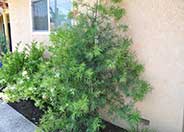
Common name:Fern Pine
Botanical name:Afrocarpus gracilior
Soft, narrow, pointed leaves on graceful arching branches characterize this plant. The foliage is gray green, and the plant can be used as an individual specimen, screen, or even a small tree.

Common name:Fox Tail Agave, Velvet Agave
Botanical name:Agave attenuata
This Agave has a dramatic tropical form. Even light frost can damage its succulent leaves. It is great for containers. In the low desert, partial sun will be best. If it becomes top heavy, simply cut and stick in the ground to root. It is not a fast grower and has light green foliage. It will also die after flowering but pups around the mother will survive. Distinctive with its large rosette of leaves perched on a long curving trunk, it is a native from Mexico.

Common name:Australian Willow
Botanical name:Geijera parviflora
Australian Willow (Geijera parviflora) is an excellent specimen tree for medium-sized gardens. This Australian native tree reaches 45’ tall and 20’ wide and is very low-water-use and low maintenance. These trees can be found in nurseries in both single-trunk and multi-trunk forms. The natural growth habit is weeping and irregular, so it does require some selective pruning and shaping when young to achieve the desired look. Thinning out the heavy, weeping branches will take some of the weight out of them, and they usually lift. The tree may require this type of pruning a few times a year for the first two or three years, but once it has achieved a height requiring a ladder to prune, it should be shaped by a licensed arborist. This tree is a slow grower and would benefit from an application of nitrogen fertilizer every year. It should be planted at least four feet away from any hardscape areas, 15 feet from structures such as houses and buildings, and not near any powerlines. Shrubs and perennials should be planted about three feet away from this tree. It should be irrigated for about 45 minutes once a week when using most in-line drip irrigation systems.

Common name:Butterfly-Iris, Fortnight Lily
Botanical name:Dietes iridioides
This clumping evergreen Iris bears tall, narrow leaves to 30" tall and white flowers marked purple in the center on stalks up to 3' tall. This variety has stiffer, darker foliage than the bicolor form. It requires sun to part shade with little or no summer watering when established.
Designer: N/A
Photographer: GardenSoft
Incorporate compost 6" into your soil to retain water, reduce compaction, feed earthworms, and provide valuable nutrients to your plants.
Drip and other smart irrigation delivers water directly to roots, allowing no excess water for weeds.